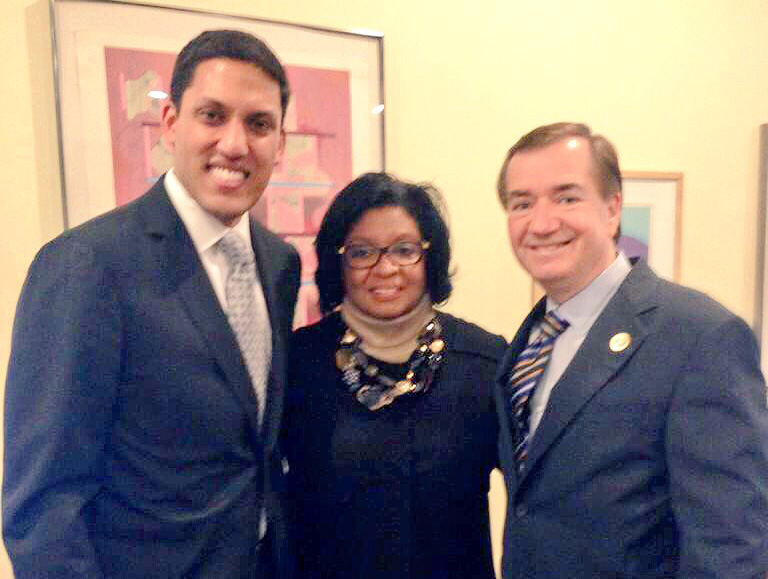
BY SONAM MIRPURI
POMONA, CA - In order to spread the word, come together and achieve the goal of ending global poverty by 2030, U S Representative Ed Royce (R-Fullerton), Chairman of the House Foreign Affairs Committee, welcomed United States Agency for International Development (USAID) Administrator Rajiv Shah to Southern California...
POMONA, CA - In order to spread the word, come together and achieve the goal of ending global poverty by 2030, U S Representative Ed Royce (R-Fullerton), Chairman of the House Foreign Affairs Committee, welcomed United States Agency for International Development (USAID) Administrator Rajiv Shah to Southern California...
for an interactive discussion on the work to combat global poverty. Cal Poly Pomona’s new President Soraya M. Coley hosted the Town Hall type meeting titled, “The Fight to End Global Poverty,” moderated by Royce.The event was held at the Bronco Student Center in California Polytechnic State University, Pomona on Jan. 11.
The event kicked off with a video presentation featuring President Barack Obama in an USAID video depicting America’s progress, mission, and means in which to end extreme poverty by 2030. “We look to the future not with fear, but with hope,” said President Obama The video highlighted the fact that an estimated 1.2 billion people live in extreme poverty. In continuing with their efforts to combat global poverty USAID strives to accelerate their progress and focus on key turnarounds in some challenging contexts and lift one billion more people out of extreme poverty over the next 20 years.
Extreme poverty refers to individuals earning below the international poverty line of $1.25 a day. However, it is more than just about the money. The more important issues at hand are the denial of basic freedoms and human dignity. These people live in conditions where they are forced to make difficult decisions every single day.
After Coley’s introductory remarks, Royce and Shah shared their insights from working on a range of pressing global development challenges, from fighting hunger to ensuring child survival to leading America’s response to natural disasters around the world.
Much needs to be accomplished prior to being able to lift so many people out of extreme poverty. Therefore it is essential that we work together to assist in completing the objective. “The focus to end poverty is to engage in partnerships with businesses, colleges, and universities,” said Shah. Science, technology, innovation, and partnerships with schools like Cal Poly Pomona contribute to further USAID’s development objectives around the world. USAID seeks to foster science-and-technology based solutions and a global marketplace of innovations to help end extreme poverty by 2030. “With the help of Deans and Professors we are able to link students to these programs,” said Royce emphasizing that utilizing school faculties to spread the word about such programs can reach future generations that are interested in helping the cause.
The event kicked off with a video presentation featuring President Barack Obama in an USAID video depicting America’s progress, mission, and means in which to end extreme poverty by 2030. “We look to the future not with fear, but with hope,” said President Obama The video highlighted the fact that an estimated 1.2 billion people live in extreme poverty. In continuing with their efforts to combat global poverty USAID strives to accelerate their progress and focus on key turnarounds in some challenging contexts and lift one billion more people out of extreme poverty over the next 20 years.
Extreme poverty refers to individuals earning below the international poverty line of $1.25 a day. However, it is more than just about the money. The more important issues at hand are the denial of basic freedoms and human dignity. These people live in conditions where they are forced to make difficult decisions every single day.
After Coley’s introductory remarks, Royce and Shah shared their insights from working on a range of pressing global development challenges, from fighting hunger to ensuring child survival to leading America’s response to natural disasters around the world.
Much needs to be accomplished prior to being able to lift so many people out of extreme poverty. Therefore it is essential that we work together to assist in completing the objective. “The focus to end poverty is to engage in partnerships with businesses, colleges, and universities,” said Shah. Science, technology, innovation, and partnerships with schools like Cal Poly Pomona contribute to further USAID’s development objectives around the world. USAID seeks to foster science-and-technology based solutions and a global marketplace of innovations to help end extreme poverty by 2030. “With the help of Deans and Professors we are able to link students to these programs,” said Royce emphasizing that utilizing school faculties to spread the word about such programs can reach future generations that are interested in helping the cause.



 RSS Feed
RSS Feed
